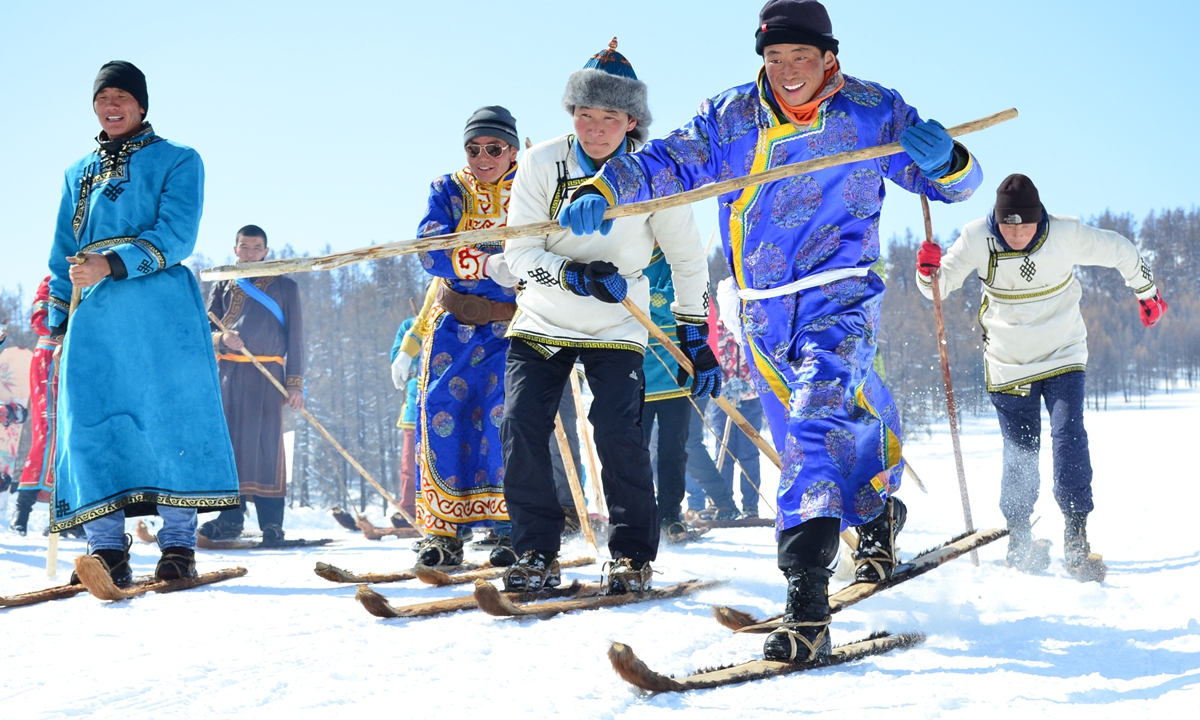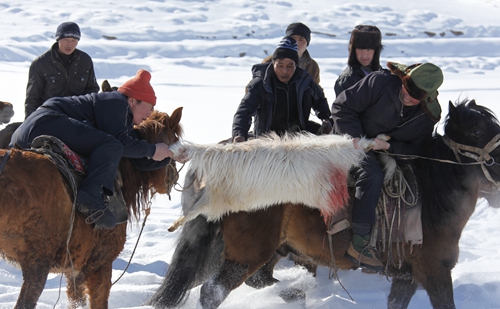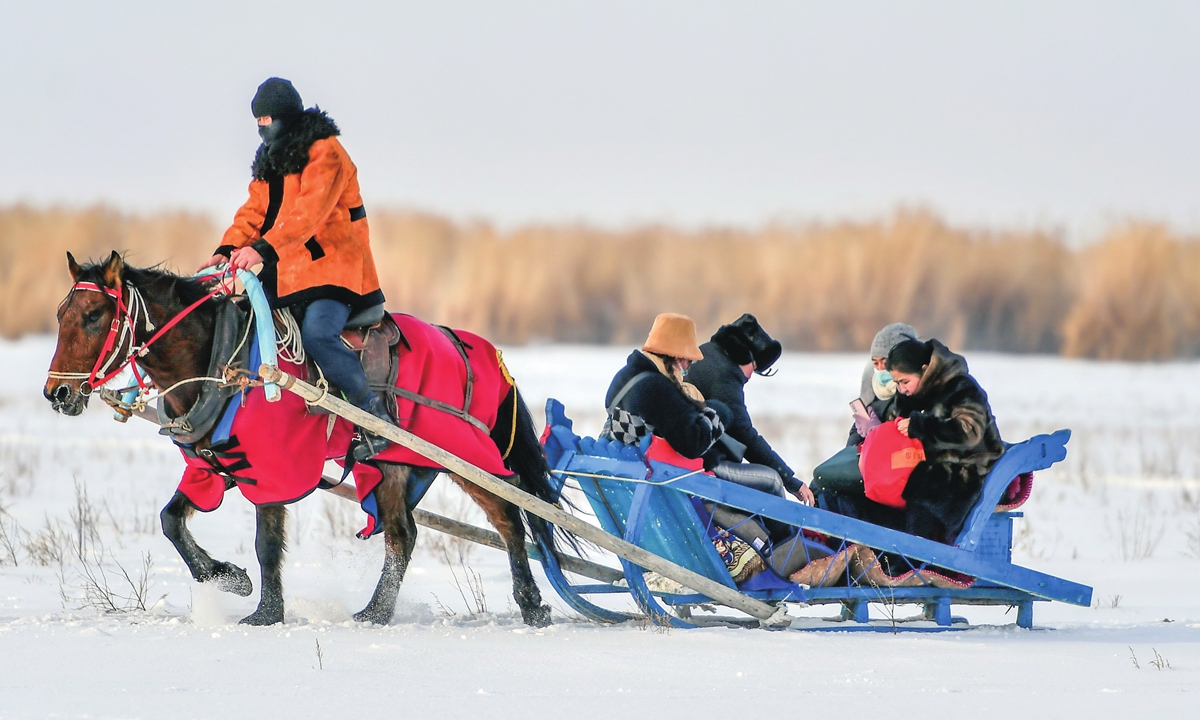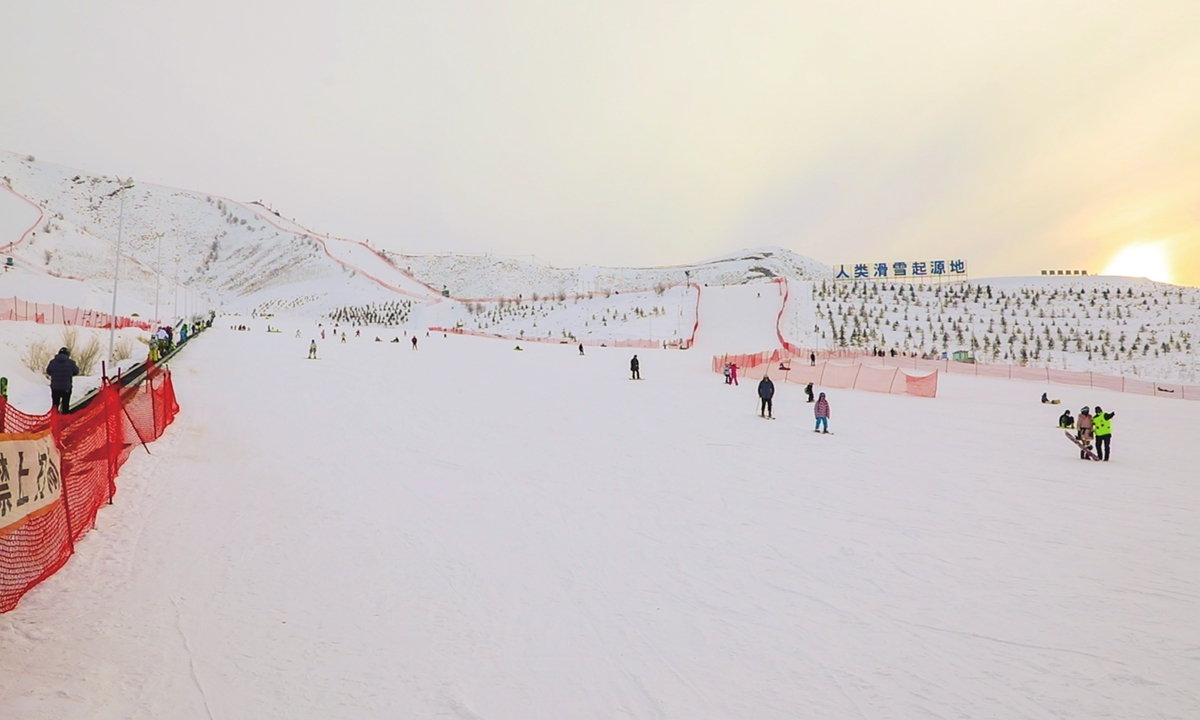
Chinese athlete Dinigeer Yilamujiang (left) and Zhao Jiawen put the torch in the center of a giant snowflake during the grand opening ceremony of the Beijing 2022 Winter Olympic Games on February 4, 2022, making it an innovative and low-carbon Olympic cauldron. Photo: VCG
Under the gaze of the world, two young Chinese athletes placed a torch in the center of a giant snowflake during the grand opening ceremony of the Beijing 2022 Winter Olympic Games, making it an innovative and low-carbon Olympic cauldron. One of the two athletes, Dinigeer Yilamujiang, is a 22-year-old of Uygur ethnicity, hailing from Altay of China's Xinjiang region.
Dinigeer was born in the Altay Prefecture, located in the northern part of the Xinjiang Uygur Autonomous Region, widely acknowledged as the birthplace of human skiing.
Since 2009, the prefecture had promoted skiing classes among primary and middle schools, and together with a dozen of children, Dinigeer was trained by her father - a skier who once claimed second prize in a national competition in 1993.
From the mountains of Altay to the National Stadium in Beijing, Dinigeer will not stop pursuing her dreams - representing China at the international sports events.
Despite Western-influenced hype regarding China's Xinjiang region, along with all sorts of distorted "facts" accusing the region of suffering from so-called human rights violations - most evident in the recent boycott of Xinjiang-grown cotton - the region is vigorously growing to become one of the most popular destinations for winter sports, especially skiing, among the Chinese public.
Ahead of the Beijing 2022 Olympic and Paralympic Winter Games, the Global Times reporters visited the Altay Prefecture. It shares its borders with Russia, Kazakhstan, and Mongolia, with a borderline of a staggering 1,197 kilometers and a total area of 118,000 square kilometers. According to the seventh national census, the population of the Altay region stands at 668,587 as of November 1, 2020.
Standing at 45 degrees north latitude, which is dubbed "the golden snow line," Altay is the internationally recognized origin of human skiing activities, which can be traced back 12,000 years. It also gained the reputation of being China's "snow capital" with its incomparably good snow quality, long snow period, and mild weather rarely found in other places around the world.
Visitors from across China, some of whom even from as far afield as the hottest island province of South China's Hainan, are flocking to Altay regardless of the 10-hour-long flight, just to have a first-hand account of the "best skiing experiences of their life."
"The blossoming tourism, the welcoming people, and the joyous atmosphere in Xinjiang are perfect reflections of how locals are, far from the twisted, dark descriptions of the West, enjoying the region's peacefulness and harmony. Facts themselves speak and present a contrasting narrative to the West's accusations of alleged forced labor, genocide, and human rights violations," Jia Chunyang, an expert at the China Institutes of Contemporary International Relations, told the Global Times.

Photos: Qiao Bingxin/GT, VCG
Origin of skiingThe Winter Olympics began in 1924 in Chamonix, France, where the first competitions in ice skating, skiing, sleighing, and ice hockey were held. However, ice and snow sports events have undergone a long process of development, and before they evolved into recreational activities, ice skating and skiing were an essential part of people's productive lives during the coldest periods of the year.
In earlier times, artifacts from Scandinavian and Russian archaeology proved the existence of ancient skiing, with the oldest found in Russia dating back to 8,000-7,000 years.
In 2005, however, the record was broken when a group of farmers in the Altay region, who went to hide under a cave to escape the rain, found cave paintings depicting men queuing up and stepping on twin snowboards with prey carried on their backs.

Photo: Qiao Bingxin/GT
It turned out that, according to archaeologists' analyses, the cave paintings were drawn 12,000 years ago, some 4,000 years before the artifacts from Russia were believed to have been made, Zhang Yongjun, the "guardian" of the cave, told the Global Times.
After Beijing's successful bid to host the Winter Olympics, experts from 18 countries including Norway, Russia, Japan, and Australia paid a visit to Altay to study the "potential origin of human skiing activity," after which they jointly issued a declaration on January 18, 2015, recognizing Xinjiang's Altay as the earliest skiing region in the world.
"When they came here to study the cave paintings, although I couldn't understand what they were saying, I did know one thing: Their eyes were wide open and their mouths were constantly mumbling 'Oh, yes… Oh, yes!' [in English]" Zhang recalled. The glimmer in his eyes was the pride he possessed at being able to protect such a precious heritage, and a deep sense of responsibility of passing on the discovery to every corner of the world.
Identifying himself as "the call from the mountains" on social media, Zhang said that he has been an educator concerning the cave paintings for six years, living in the mountains alone. "I never felt lonely, because every time I went into the cave, I would feel as though I was time traveling. I was able to commune with our ancestors, learning about their joys and sorrows, their creations, and their attitudes toward life."
In addition to the earliest images, the Global Times reporters visited Slanbek Shahesh, a 65-year-old man of Kazak ethnicity and the guardian of ancient fur ski making skills - an intangible cultural heritage of Xinjiang dating back to more than 10,000 years ago. As the fourth generation craftsman, Slanbek has been making fur ski equipment for 50 years.
"In the past, skiing has been and continues to be necessary for herdsmen living in the deep mountains in winter. When making the skis, we first curve fine wood into the shape of snowboards and soak them in cold water to make them strong and durable. Then we line them in a layer of horse hair on the bottom, so that the skis can glide down the hills with as little friction as possible and scale the hills against the direction in which the fur is laid to increase traction on the snow," Slanbek's son explained.
With winter and ice sports fever sweeping across China in recent years, the ancient fur ski technique, once forgotten by the world, is now able to "resurrect," becoming a calling card in promoting tourism and snow culture in Xinjiang.
In Slanbek's workshop, fur skis of various sizes adorn the shelves, constantly giving off the unique fragrance of wood. "There are now more people buying fur skis as souvenirs. We make about four to five snowboards a week, the prices ranging from a few hundred to 7,000 yuan," Slanbek said. "We never thought that such a family tradition would change our lives."

Photo: Courtesy of Fuyun county in Altay
Skiing toward the OlympicsYinhua, or The Silver Flower, a documentary recently released documenting a 13-year-old Altay girl's dream of skiing her way into the Winter Olympic Games, has touched many people's heart. Outpacing the wind and pushing full steam ahead, the girl's perseverance and tenacity are the embodiment of thousands of young skiers fearlessly pursuing their dreams. They are the rising stars; the future backbones of China's ice and snow sports.
Growing up in a small village near where human skiing was originated, Yinhua developed her passion for skiing at a young age. However, not having received any proper training, she was unable to join a local professional ski team. The minor setback did not stop her pursuits, but made her even more determined.
The "strong-willed" girl boosted her own confidence shortly afterwards. At minus 30 C Hemu village, she started her physical trainings every morning while the whole village was still sound asleep. The perseverance in solitude caught the attention of Chinese Olympic champions Deng Yaping and Yang Yang, who all encouraged her and expressed faith in her eventual success. China's first skiing world champion, Guo Dandan, said she wanted to take Yinhua as her student.
When the Global Times asked Yinhua whether she would watch the Beijing Winter Olympics, she said she would particularly pay attention to Gu Ailing, or Eileen Feng Gu, the Chinese freestyle skier who have bagged several gold medals in skiing world championships.
Asked whether Gu is her idol, Yinhua nodded shyly as she quietly mumbled, "I will try my best to be someone like her. I would like to meet her in person at the next Winter Olympic Games where we can compete in the race together."
"I wouldn't mind if there are obstacles along the way. As my coach has always taught me, as long as you try your best, there will always come a day when you will shine," Yinhua told the Global Times.
While Yinhua could not participate in the Beijing Winter Olympic this year, there will be a group of five athletes from Xinjiang attending the Beijing Games, three of whom hail from the Altay region. In addition, 16 National Technical Officials from Altay have been selected to act as judges in the alpine skiing competition at the Games. They arrived in Beijing's Yanqing district on January 19 and entered the closed-loop venues.
Yerzati Meghti, one of the National Technical Officials who is a former champion in the short turn skiing competition at the 9th National Winter Games, told the Global Times that he has been looking forward to participating in the Beijing Winter Olympic, and will do his best to ensure the successful delivery of the events.
"My father started teaching local students how to ski in 1964. There were no ski teams back then or even professional ski boards except the ones made of wood. He would take his students to Northeast China to attend various winter games before the Xinjiang ski team was officially established in 1979, and I joined the team in 1985 following in the footsteps of my older brother," Yerzati said.
Skiing has become part of his family tradition that runs in his blood, he said, as most of his family members were all once ski athletes.

Photos: Qiao Bingxin/GT, VCG
Unique advantages Chinese Foreign Ministry spokesperson Zhao Lijian has recently been promoting snow and ice sports in Xinjiang for several days in a row, particularly highlighting skiing experiences in the Altay region with pictures of the Jiangjunshan Ski Resort and the hashtag "I'm welcoming the Winter Olympic Games in Xinjiang."
Built in 2009, the Jiangjunshan Ski Resort is only 1 kilometer away from the city center, the only alpine ski resort in China connected to the city. Compared with other ski resorts in China that cost at least a few hundred yuan, the Jiangjunshan Ski Resort is only 160 yuan for a day, about half the price of the others.
For skiers checking into nearby hotels, they would get three or four days of free tickets to access the resort throughout the day, and have buses pick them up from and drop them off at the hotel.
Compared with other ski resorts in China or popular ski destinations around the world, Altay has the unique advantages of having an ultra-long snow season which lasts from November to May, Yerzati told the Global Times. According to statistics from the local meteorological department, the annual snowfall days in Altay have reached 179, with annual snow storage days reaching 157 in total. The city was named China's "snow capital" by the National Climate Center in 2019.
"What's more, the snow is of excellent quality and quantity," Yerzati said, adding that people can experience skiing on powder snow that's softer and smoother than regular snow.
The climate in Altay is milder and is less windy, so skiers get less affected by weather conditions, allowing them to move faster and more accurately.
As the Global Times reporters enjoyed a few outings in the Jiangjunshan Ski Resort and a newly built but even larger one in Hemu village, they found that although the temperatures were -15 C on average late January, the apparent weather was not cold at all since there was no wind. At such temperatures, thermal clothes or down jackets even seemed unnecessary.
Those who have also fallen in love with the ski resorts in Xinjiang like Zhao Lijian are ski enthusiasts from across the country. From flights to Urumqi and Altay to the hotels near the ski resorts, the Global Times found everything to be fully booked by people talking in various accents from different places, totting their ski boards and luggage, with some taking their kids along.

Photos: Qiao Bingxin/GT, VCG
"There has been a ski fever among youngsters in recent years, and people have the idea that whoever knows how to ski must be cool," said a skier from Southwest China's Guizhou Province. "Now as the Beijing Winter Olympic Games is about to open, I feel like our passion for skiing is set to grow even more," said another from Central China's Hunan Province.
"The unwarranted slander and suppression against Xinjiang has not affected Xinjiang's socioeconomic development but has instead awakened Chinese people's patriotism and their support for Xinjiang, mostly evident in the region's winter tourism," Jia Chunyang noted. "People are now posting photos and videos of Xinjiang's ski resorts and winter scenes on social media spontaneously. The accusations from the West have, in fact, helped bring people from across China even closer."
Altay has also made some considerate yet "humorous" designs to provide convenience to tourists. The city buses, for example, are equipped with "little backpacks" - a long box at the rear for placing ski boards; the ski resort provides free wifi named "Please wear your mask properly," so that people are reminded about COVID-19 prevention while accessing the internet.
In a recently released report on China's ice and snow tourism development, it showed China's ice and snow tourism trips had reached 230 million, with an income exceeding 390 billion yuan in the 2020-2021's winter season. Northeast China, the Beijing-Tianjin-Hebei area, and Xinjiang are playing a pivotal role. Xinjiang, where winter events span mainly along the Altay and Tianshan mountains, now has 72 ski resorts.
In 2021, the Altay region received a total of about 34.4 million tourists, a year-on-year increase of 59 percent, realizing a tourism revenue of 26.3 billion yuan, an increase of 87 percent compared with 2020, the Global Times learned from local authorities.









